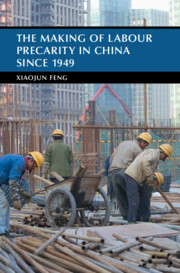Refine search
Actions for selected content:
2634 results
11 - Stacking Up for Resilience
- from Part II - Case Studies
-
-
- Book:
- Securing Democracies
- Published online:
- 19 December 2025
- Print publication:
- 22 January 2026, pp 237-272
-
- Chapter
-
- You have access
- Open access
- HTML
- Export citation
Introduction
-
- Book:
- Connected Cartographies
- Published online:
- 11 December 2025
- Print publication:
- 22 January 2026, pp 1-16
-
- Chapter
- Export citation
3 - The Changing Meaning of Corruption and Anti-corruption in Postwar China
- from Part I - Emergence
-
-
- Book:
- A Comparative Historical Sociology of Corruption
- Published online:
- 19 December 2025
- Print publication:
- 22 January 2026, pp 52-71
-
- Chapter
- Export citation
12 - AI Governance in East Asia
- from Part IV - Emerging Problems
-
-
- Book:
- Inter-Asian Law
- Published online:
- 16 December 2025
- Print publication:
- 22 January 2026, pp 229-246
-
- Chapter
-
- You have access
- Open access
- HTML
- Export citation
14 - In the Shadow of Sovereignty
- from Part IV - Emerging Problems
-
-
- Book:
- Inter-Asian Law
- Published online:
- 16 December 2025
- Print publication:
- 22 January 2026, pp 265-286
-
- Chapter
-
- You have access
- Open access
- HTML
- Export citation
5 - Law of the Sea
- from Part II - Property Rights and Economic Exchange
-
- Book:
- Politics and International Law
- Published online:
- 23 December 2025
- Print publication:
- 22 January 2026, pp 167-194
-
- Chapter
- Export citation
13 - The “Smart City” Debate
- from Part IV - Emerging Problems
-
-
- Book:
- Inter-Asian Law
- Published online:
- 16 December 2025
- Print publication:
- 22 January 2026, pp 247-264
-
- Chapter
-
- You have access
- Open access
- HTML
- Export citation
Chapter 3 - Food Safety, Risk Society, and Political Trust
- from Part I - Political Guardianship Psychology and Political Trust
-
- Book:
- The Political Psychology of Citizens in Rising China
- Published online:
- 04 December 2025
- Print publication:
- 08 January 2026, pp 88-112
-
- Chapter
- Export citation
Introduction
-
- Book:
- Cold War Comrades
- Published online:
- 25 December 2025
- Print publication:
- 08 January 2026, pp 1-18
-
- Chapter
- Export citation
Chapter 2 - Modernization, Life Satisfaction, and Political Trust
- from Part I - Political Guardianship Psychology and Political Trust
-
- Book:
- The Political Psychology of Citizens in Rising China
- Published online:
- 04 December 2025
- Print publication:
- 08 January 2026, pp 62-87
-
- Chapter
- Export citation
Chapter 7 - Traditional Values and Support for Democracy
- from Part II - Political Guardianship Psychology and Democracy
-
- Book:
- The Political Psychology of Citizens in Rising China
- Published online:
- 04 December 2025
- Print publication:
- 08 January 2026, pp 203-224
-
- Chapter
- Export citation
Chapter 8 - Perceptions of Democracy and Democratic Satisfaction
- from Part II - Political Guardianship Psychology and Democracy
-
- Book:
- The Political Psychology of Citizens in Rising China
- Published online:
- 04 December 2025
- Print publication:
- 08 January 2026, pp 225-251
-
- Chapter
- Export citation
5 - Where Unicorns Are Born: Innovation Hubs in China
-
-
- Book:
- Unicorns from Emerging Economies
- Published online:
- 05 December 2025
- Print publication:
- 08 January 2026, pp 129-150
-
- Chapter
- Export citation
Chapter 4 - Government Performance and Multilevel Political Trust
- from Part I - Political Guardianship Psychology and Political Trust
-
- Book:
- The Political Psychology of Citizens in Rising China
- Published online:
- 04 December 2025
- Print publication:
- 08 January 2026, pp 113-139
-
- Chapter
- Export citation
Conclusion
-
- Book:
- Cold War Comrades
- Published online:
- 25 December 2025
- Print publication:
- 08 January 2026, pp 238-249
-
- Chapter
- Export citation
Chapter 10 - Evaluations of Democracy in the United States, India, and Taiwan
- from Part II - Political Guardianship Psychology and Democracy
-
- Book:
- The Political Psychology of Citizens in Rising China
- Published online:
- 04 December 2025
- Print publication:
- 08 January 2026, pp 280-308
-
- Chapter
- Export citation

Cold War Comrades
- An Emotional History of the Sino-North Korean Alliance
-
- Published online:
- 25 December 2025
- Print publication:
- 08 January 2026
Policy Innovation by China’s Local Governments: Beyond the “Championship” Model
-
- Journal:
- The China Quarterly , First View
- Published online by Cambridge University Press:
- 22 December 2025, pp. 1-19
-
- Article
-
- You have access
- Open access
- HTML
- Export citation

The Making of Labour Precarity in China since 1949
-
- Published online:
- 19 December 2025
- Print publication:
- 22 January 2026

Justice for Some
- A Comparative Study of Miscarriages of Justice and Wrongful Convictions
-
- Published online:
- 19 December 2025
- Print publication:
- 22 January 2026
-
- Book
-
- You have access
- Open access
- Export citation
